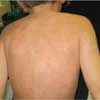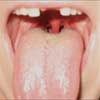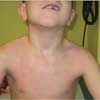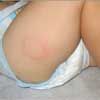Photo Quiz: Making the Rounds: Round 2
The rash on the upper torso, arms, and back of an 11-year-old started after he had a headache and fever for 3 days. The patient also has a distinctive pharyngitis with redness and some petechiae.



Case 1:
The rash on the upper torso, arms, and back of an 11-year-old started after he had a headache and fever for 3 days. The patient also has a distinctive pharyngitis with redness and some petechiae.
Would you order a confirming test or would you treat empirically with antibiotics?
Case 1: Identifying acute pharyngitis caused by group A ß-hemolytic streptococcus is a standard task for pediatricians. But are the signs and symptoms of this disease reliable enough that we can forgo the use of a confirming rapid strep test or a throat culture?
Based on a study by Lin and colleagues,1 it appears that although sore throat, tonsillar swelling, and scarlatiniform rash increase the likelihood of a positive test result, the positive predictive value of each sign is still less than 50%. The combination of all these positive signs (as in this patient) does improve predictability, but they rarely occur together.
Recently published guidelines by Wong and coworkers2 highlight the possibility of using a scoring system to determine whether and when to use antibiotics in acute upper respiratory tract infections. Their system gives points to specific aspects of the clinical history and physical examination. For example, a child with a sore throat can "earn" 1 point for each of the following: fever, absence of cough, cervical adenopathy, tonsillar exudates, and scarlatiniform rash. If a patient receives a score of 4 or 5 points, then empiric treatment can be considered--especially when the child does not comply with efforts to obtain a throat swab. Fortunately, the patient in this case was compliant; results of a rapid strep test were positive.
Case 2:
This large, raised, well-demarcated lesion developed on the outer aspect of the thigh in this 14-month-old boy. Similar lesions were developing on his other leg and ankle.
What's going on?
Case 2: The lesions are from urticaria. Between 15% and 25% of the general population are affected at some point. These lesions rarely progress to systemic anaphylaxis. Urticaria may manifest with multiple erythematous wheals or, occasionally, to the plaques, as seen in this toddler. These lesions can be intensely pruritic or may only cause mild discomfort.
It is often difficult to determine the cause of urticaria. A viral etiology and some type of exposure (topical or ingested) are the most common causes.
This toddler did have some symptoms of upper respiratory tract infection. His mother also reported that he had eaten a peanut butter cluster bar earlier on the same day he was seen by the pediatrician. The mother was advised to avoid feeding her son any nuts until formal skin testing could be done. The child was also given an antihistamine along with long-acting cetirizine (Zyrtec).

Case 3:
This lesion has been present since birth. The child's mother has become more concerned about it and wants to know whether she should seek a dermatologist's opinion.
What would you advise?
Case 3: This is an epidermal nevus. Epidermal nevi are generally present at birth but can first appear during adolescence. The lesions are usually asymptomatic but can sometimes be itchy.
Nevi are linear, hyperpigmented plaques (varying from pink to black). They may be velvety to verrucous, thin to thick, limited to extensive. These lesions generally occur on the trunk or extremities and follow the lines of Blaschko.1 (These lines may represent cutaneous mosaicism.)
Nevi are separated into 2 histologic types2:
•Non-organoid (keratinocytic).
•Organoid (sebaceous, follicular, and sweat gland).
Squamous cell and basal cell carcinoma can rarely develop from the keratinocytic type. Therefore, as the patient ages, the parents should consider seeing a dermatologist for further evaluation and possible biopsy or removal if the lesion is not too extensive.

Case 4:
This 2-year-old boy was brought to the pediatrician's office because of this rash. The patient had been seen 5 days earlier for an acute otitis media infection. He was treated with amoxicillin/clavulanate (Augmentin). After 4 days of therapy, lesions began to develop on his legs and upper back with rapid progression. The patient had no oral or mucosal lesions and did not complain of any significant itching or discomfort. The rash was distinctive for large confluent macules, distinctive borders, raised areas, and target lesions.
What is this rash, and what treatment would you recommend?
Case 4: This is erythema multiforme (EM). The annual incidence of EM is unknown, but it probably occurs in about 1 in 500 children. The cause of this distinctive rash includes infectious agents (eg, herpesvirus and mycoplasma), but drugs--specifically antibiotics--are most commonly involved. More than 100 drugs have been implicated: sulfonamides, NSAIDs, and penicillins are the most commonly associated agents.
The term erythema multiforme was first described by von Hebra in the 19th century.2 In 1922, Stevens and Johnson3 described 2 cases of EM associated with fever, stomatitis, and conjunctivitis: the condition is now called Stevens-Johnson syndrome (SJS). In 1956, Lyell4 described a process in which the skin was damaged over a large surface, leaving a scalded appearance. This came to be known as toxic epidermal necrolysis (TEN) or Lyell syndrome. Although EM and TEN are histologically distinct, EM, SJS, and TEN tend to be viewed as part of a spectrum representing increasingly severe manifestations of a clinical disease process.
References:
REFERENCES:
1.
Lin MH, Fong WK, Chang PF, et al. Predictive value of clinical features in differentiating group A b-hemolytic streptococcal pharyngitis in children.
J Microbiol Immunol Infect.
2003;36:21-25.
2.
Wong DM, Blumberg DA, Lowe LG. Guidelines for the use of antibiotics in acute upper respiratory tract infections.
Am Fam Physician.
2006;74:956-966.
REFERENCES: 1. Bolognia JL, Orlow SJ, Glick SA. Lines of Blaschko. J Am Acad Dermatol. 1994;31:157-190.
2. Happle R, Rogers M. Epidermal nevi. Adv Dermatol. 2002;18:175-201.
REFERENCES: 1. Forman R, Koren G, Shear NH. Erythema multiforme, Stevens-Johnson syndrome, and toxic epidermal necrolysis in children. Drug Safety. 2002;25: 965-972.
2. von Hebra F. On the polymorphous erythemata, I: erythema exudativum. In: Fragge CH, ed. On Diseases of the Skin, Including the Exanthemata. Vol. 1. London: New Syndenham Society; 1866:285-289.
3. Stevens AM, Johnson FC. A new eruptive fever associated with stomatitis and ophthalmia. Am J Dis Child. 1922;24:526-533.
4. Lyell A. Toxic epidermal necrolysis: eruption resembling scalding of the skin. Br J Dermatol. 1956: 68:355-361.